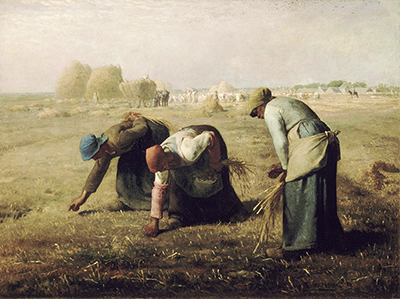The Gleaners was an oil on canvas painting done by Francois Millet in 1857. He depicts a group of three gleaners at work. Gleaning was the process of scouring fields for sheaves that might have been left after harvest. This was only allowed to the poorest in the society and a license was required. Therefore, anyone who was gleaning was a desperate, miserable person.
This image was first meant to be an art of nature. However, Millet sought to depict the hardships that the impoverished faced in society while still showing nature. Millet was a champion of the low in the society, often depicting people working in fields with pieces of art such as Angelus and Shower. However, in this painting, he went further to show three women who had no place in society due to their poverty.
The painter had deliberately painted a low sky in his piece, almost taking half of the canvas size. This was to emphasize the sense of recession and how the gleaners are removed from the society as no one had the time for them. They were marginalised and shut out of the support systems in the community.
He also shows some parallels and contrasts through symbols. For example, the sheaves that women gather are very few compared to the huge stacks that are gathered at the background of the image. Again, the clothing that the three women wore seems to be spun at home. The clothing looks heavy with a tight cloth running across their loins, another sign of poverty.
Finally, the three women seem tired with repetitive, unforgiving physical activity. One of them is taking a pause, probably for having bent for an extended period. Unfortunately, they have little to show for their efforts as they have collected very few sheaves. This is a depiction of hopelessness and pain. However, without an alternative, there is little that women can do to redeem their situation.
Style of the art
Millet created this piece of art while at Barbizon School. The leaders of the school wanted a return to nature-focused art. Therefore, they taught and encouraged realism, which was inspired by the new wave of renaissance that was sweeping across France. Realism differed from naturalism in that it highlighted rural scenes, street life, clubs and an increasing need to paint the body and objects as they looked in real life. The middle and upper class in the society did not like it. That is why realists’ pieces of work took time to gain acceptance.




